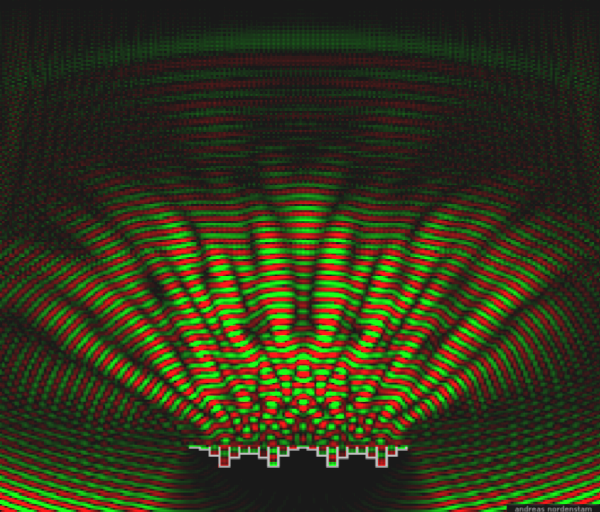Could you do a quick sketch of the room layout, with dimensions, Steve? I suspect that the room isn't really big enough to successfully use most types of diffusion, specifically those based on numeric sequences. I'm not sure if you have read "Acoustic Absorbers and Diffusers" by Cox and D'Antonio (it is THE book on the subject! Lots of math, but lots of explanations too). They layout the principles of physics that diffusion depends on, and the theory of how diffusers work, as well as lab testing.. and the conclusion that they arrive at is that you should never sit closer than ten feet (3 m) to a diffuser, because... :

- QRD-Diffusion-lobing--pattern-graph-SML-ENH-2.PNG (335.89 KiB) Viewed 24291 times

- QRD-Diffusion-lobing--pattern-graph-SML-ENH-2.PNG (335.89 KiB) Viewed 24291 times
The diffuser is down the bottom of the photo, and the drunk mangled rainbow pattern represents the results of the diffusion, in terms of the phase (the same happens in frequency, time, and intensity, all overlaid in the same space). As you can see close to the diffuser is a mess! Even a small move of your head will put your ears in different parts of that jumbled muddle of phases, times, frequencies, and levels. It's not until you get quite far away that it all smooths over into a proper diffuse field (right at the top of the photo). Cox and D'Antonio say 10 feet, minimum, but they also say three full wavelengths of the lowest frequency scattered by the diffuser. If that distance turns out to be more than 10', then go with that. If it is less than 10 feet, then still don't get closer than 10 feet.
Thus, a numeric sequence diffuser should always be at least ten feet away from the ears of anyone doing critical listening.
Of course, the manufacturers of these devices don't tell you that (I wonder why?

), and most home studio owners never read books like that, so you see photos all the time of beautiful QRD's and PRD's and phase gratings (Schroeder diffusers), and other things on the rear walls of studios... then those poor folks wonder why their mixes don't translate so well ...

Even in pro studios, you still often see large diffusers on the rear wall... far away from the engineers head at the mix position, sure, but then there's a client couch right in front if it! With heads just a few inches away... Sigh!
So, careful with diffusers in your room. You might need some type of diffusion, but if so then probably polys would be the best, since polys do not cause phasing or frequency issues: only direction.
After 10 years in this room and countless recordings I have the room actually sounding decent.
Maybe you could do a REW test in there? Like this:
How to calibrate and use REW to test and tune your room acoustics Post the resulting MDAT file here, and I'll take a look at it for you. And be prepared! There might be stuff in there that you never realized...
I attribute this mostly to the odd assortment of Homasote panels (go figure, right?) that I have scattered about.
Ah, well, there's your problem! You used Homasote!



Just joking! Seriously, that's good stuff, and I do use it in many of my room designs... but not in the way you are using it. It's doing something, acoustically, for sure, but perhaps not all of the right things, and perhaps not enough. The REW data will reveal the truth...
I theorize that these panels may be causing the acoustic energy to be more specularly reflected rather than incidentally reflected and therefore preventing a lot of low frequency modes.
I'm not convinced! But we'll see what the REW data says. I would suspect that the Homasote is absorbing in the mid range, perhaps up to fairly high, but reflective in the high end, and somewhat in the low end. It suspect that it acts sort of like very dense insulation, with very high gas flow resistivity (you guys should measure that! It would be interesting: not very useful for your sales purposes, but interesting anyway, as a curiosity), and thus not much absorption in the very low end of the spectrum. However, there might be a membrane effect too, since the panel isn't very rigid, so you could be getting some interesting low frequency effects from that.
Your couch is probably doing more for the low end than the panels are.
Of course, I'm just speculating wildly here... REW will show what your room is really doing, then we can figure out if you need more treatment, and if so, what / where.
I had a lot of high frequency absorption in the room at one point (hit or miss application) but the room lost all its character to my ears.
Exactly! Most small rooms don't need any high-end treatment, or very little. They need huge stacks of LOW end treatment, but the high end often isn't too bad at all. So if you do treat the high end, the room sounds dull, lifeless, hollow, uninteresting...
The second is the corner that I play into
You have your room set up facing into a corner?

I'm really interested in seeing the REW data now!

- Stuart -